Central Washington’s Colchuck Lake hike rewards trail blazers with a jaw-dropping turquoise lake nestled under some of the most dramatic peaks in the PNW. A challenging trail, hiking Colchuck Lake takes some advance planning, so we put together this guide with everything you need to know!
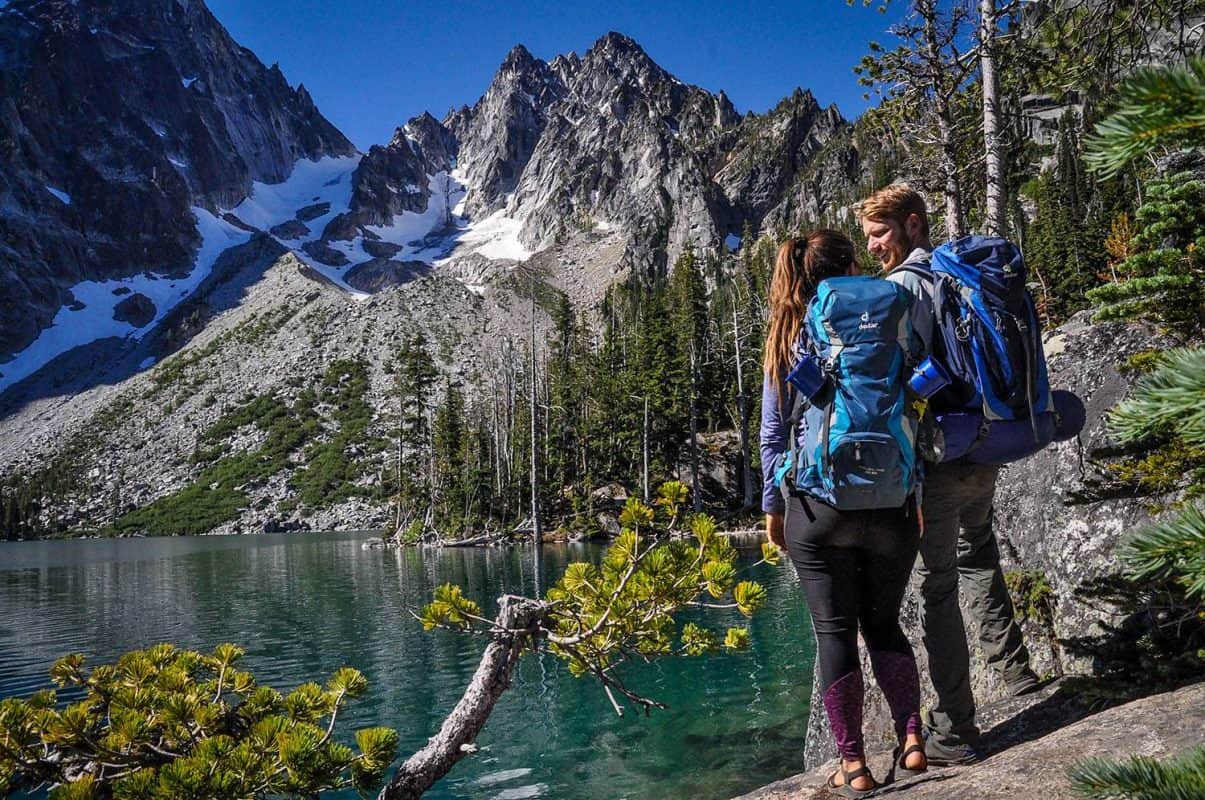
When we close our eyes and picture our happy place, one of those spots is Colchuck Lake.
This glacial lake is nestled at the base of the Enchantments Wilderness Area near Leavenworth, Washington, and it is well worth the hike to get there.
Since living in Leavenworth, we’ve hiked the Colchuck Lake trail many times (most recently with our daughter in August 2023), and can say without a doubt that it’s one of our favorite hikes in Washington.
Before you pack your backpack (with a picnic lunch, of course!) and lace up your hiking boots, we’ve got some insider tips for you. We’ve created a guide with everything you need to know about hiking to Colchuck Lake so you can be prepared for an epic adventure!
Colchuck Lake Hiking Guide
- Colchuck Lake trail stats
- Colchuck Lake hike overview
- Colchuck Lake trail map
- Know before you go
- The route
- Tips for hiking to Colchuck Lake
- Where to camp near Colchuck Lake
- What to pack
Psst! For our favorite places to grab food after your hike (+ all sorts of other tips!), check out our Leavenworth, WA guide!

Colchuck Lake hike stats
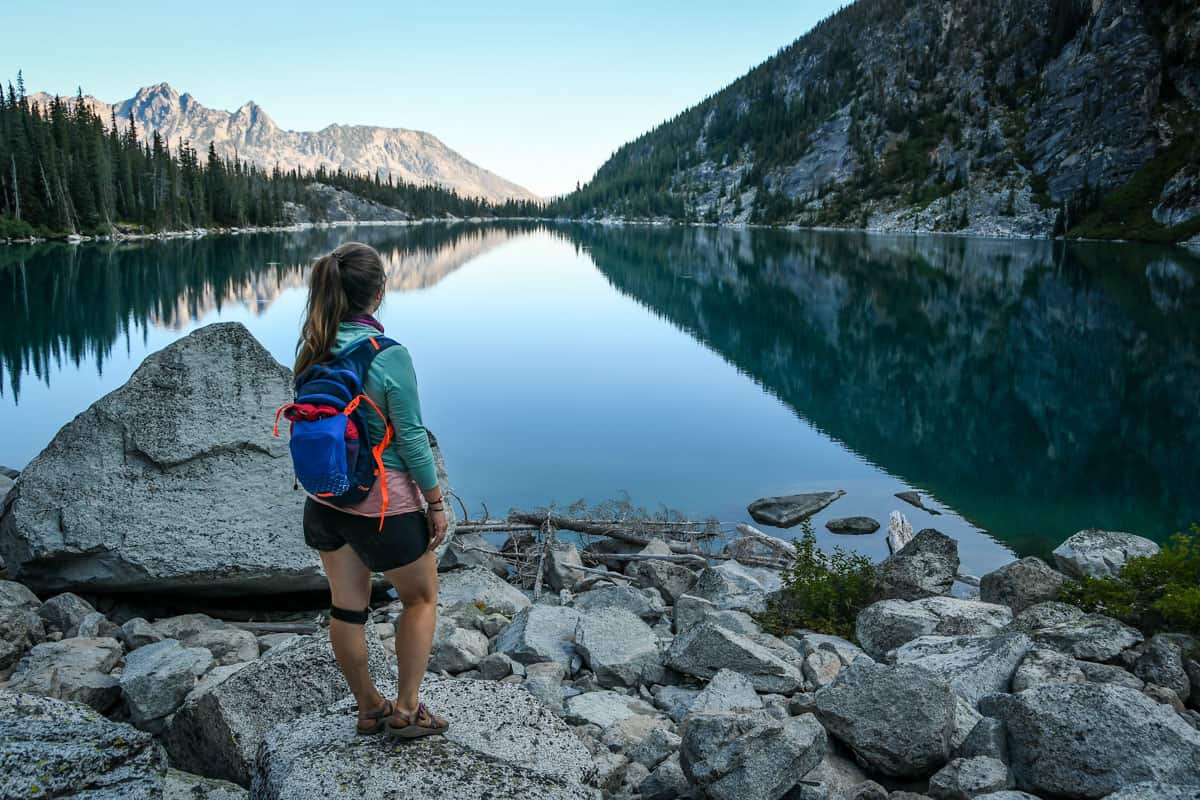
- Location: The Enchantments Wilderness Area; 13 miles Southwest of Leavenworth
- Type of hike: Out and back
- Distance: 8 – 9 miles, depending on how far along the lake you go
- (it is roughly 4 miles just to get to the lake)
- Elevation: 2,280+ feet
- Difficulty Rating: Moderately challenging
- Timing: 4-5 hours hiking time (depending on your fitness level and pace)
- Tip: Allot an additional 1 – 1.5 hours minimum for hanging out at the lake
- Pets: dogs are prohibited on Colchuck Lake trail and in the entire permitted Enchantments area
- Camping: To camp at Colchuck Lake, you will need a permit
- Permits: Wilderness permits for day use required; self-issuing permits available at the trailhead
- Trail notes on Alltrails
Colchuck Lake hike overview

Tackling the Colchuck Lake trail requires you to break a serious sweat, but it’s well worth it, as the hike takes you to one of Washington’s most spectacular alpine lakes.
Flanked by rugged, snow capped mountain peaks – like the iconic Dragontail – the water creates a perfect, mirror-still reflection of the impressive landscape on sunny days.
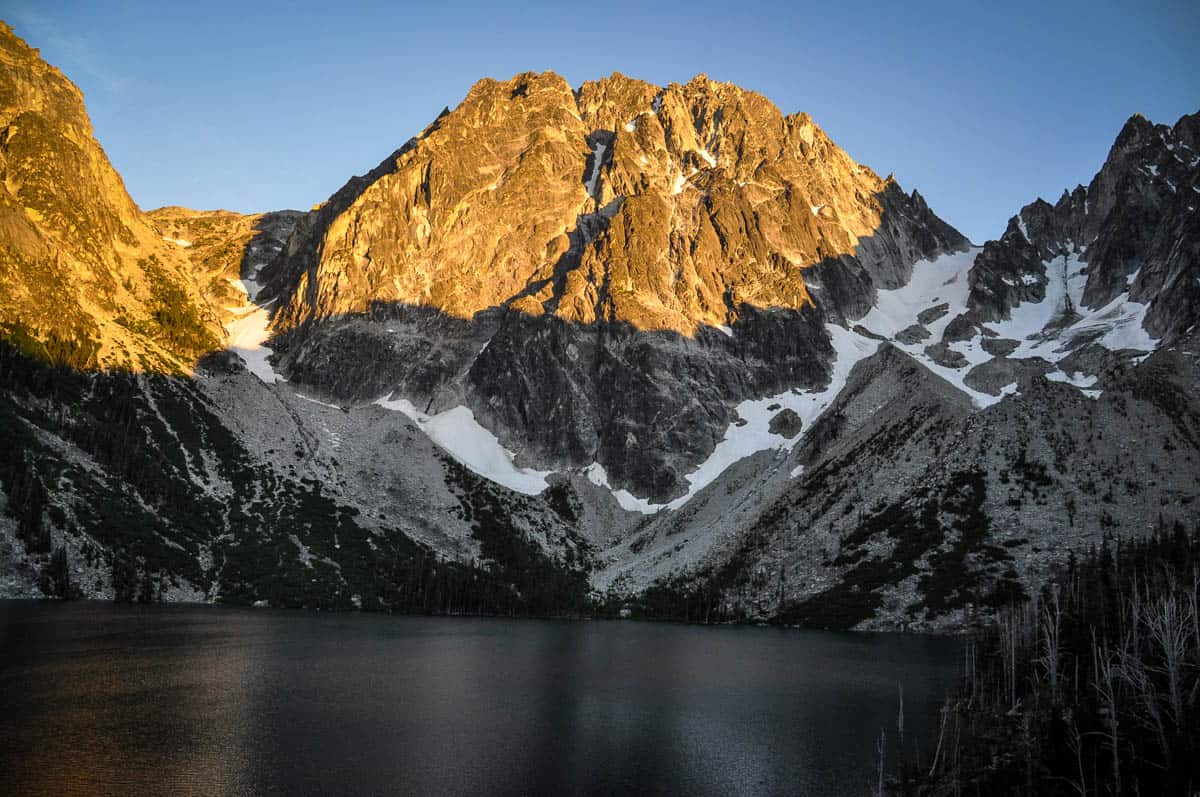
Add in the vibrant glacial turquoise color, opportunities for swimming, and it’s not at all surprising the Colchuck Lake hike is so popular. In fact it’s one of our very favorite hikes near Leavenworth!
In spite of the trail’s popularity, Colchuck Lake itself is rarely swamped with people, even on the busiest days. The shoreline fortunately has several little nooks for relaxing, so it’s easy to stake a claim to enjoy a picnic and take plenty of photos.
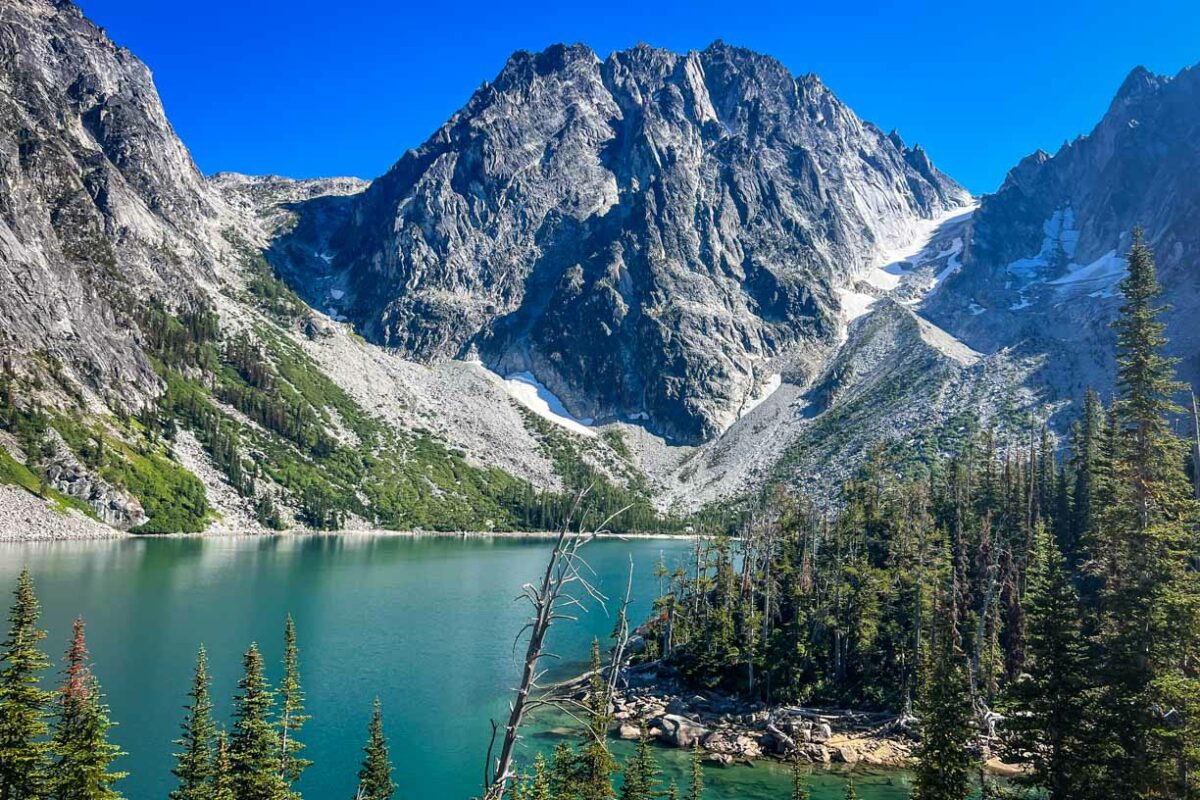
The Colchuck Lake trail is also the most accessible entry point into the storied (and appropriately named!) Enchantments hike, one of the most stunning hikes in Washington. Here, tucked deep in the Cascades, you’ll find breathtaking scenery, more than 700 alpine lakes, and epic rock climbing.
The Colchuck Lake trail mostly passes through woods and while it packs a substantial elevation gain, it’s doable for just about anyone and doesn’t feel overly crowded. So lace up your hiking boots and get ready to hit the trail!
Colchuck Lake trail map
Things to know before you hike to Colchuck Lake
There are some logistics to consider before embarking on the Colchuck Lake hike. We’ve broken down the essentials below.
Best time of year to hike the Colchuck Lake Trail
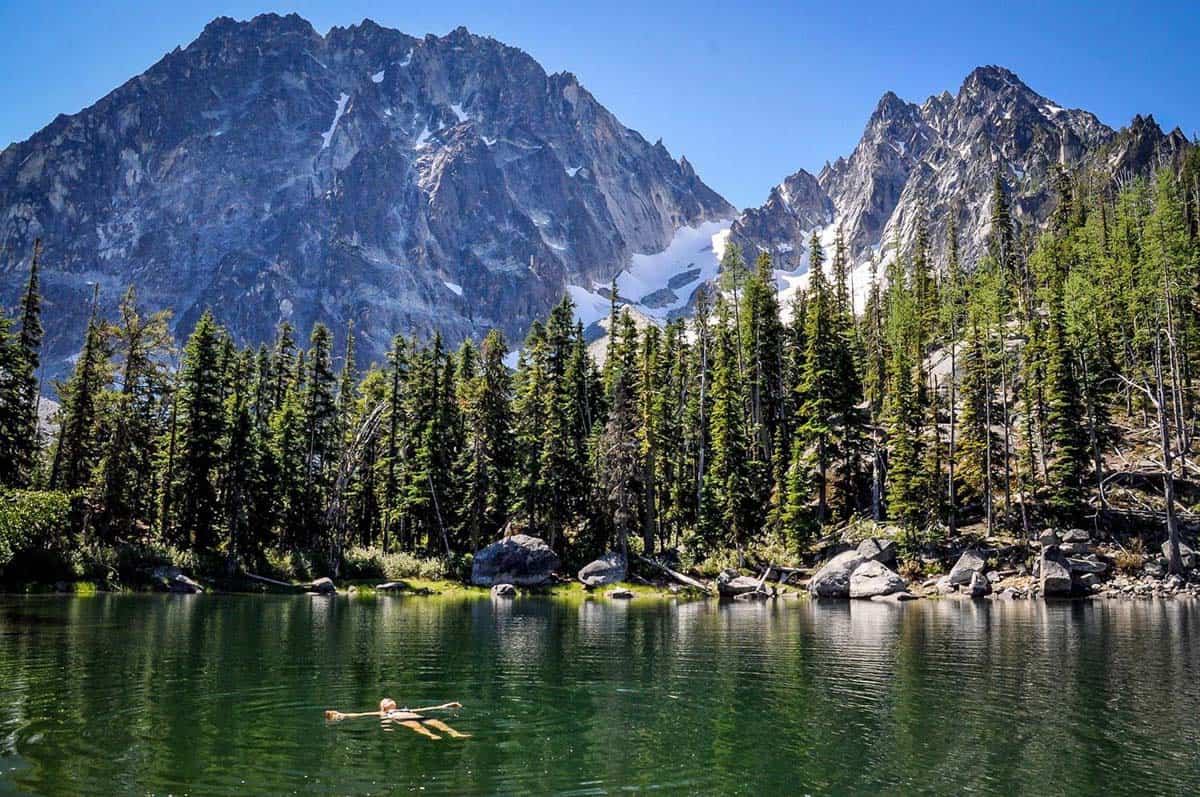
Late June to October are the best months for hiking to Colchuck Lake.
In fact, the trailhead is actually inaccessible for much of the rest of the year, since Forest Service Road 7601 closes from November to May.
In the winter, experienced snowshoers can tack on the extra seven miles to see the lake beautifully frozen over. We haven’t attempted it personally, and wouldn’t recommend it without proper gear and experience.
We love Colchuck Lake on hot summer days. Sure, the hike can get toasty and sweaty, but a plunge in the refreshingly cool water is the perfect finale! Keep in mind that July through August is peak hiking season, so the trail gets crowded, especially on weekends.
Finally, unless there’s an early fall blizzard, October is an absolutely fantastic month for the Colchuck Lake hike. There are far fewer crowds, and the larch trees paint the valleys with a stunning fiery orange-yellow color!
How long does it take to hike to Colchuck Lake?
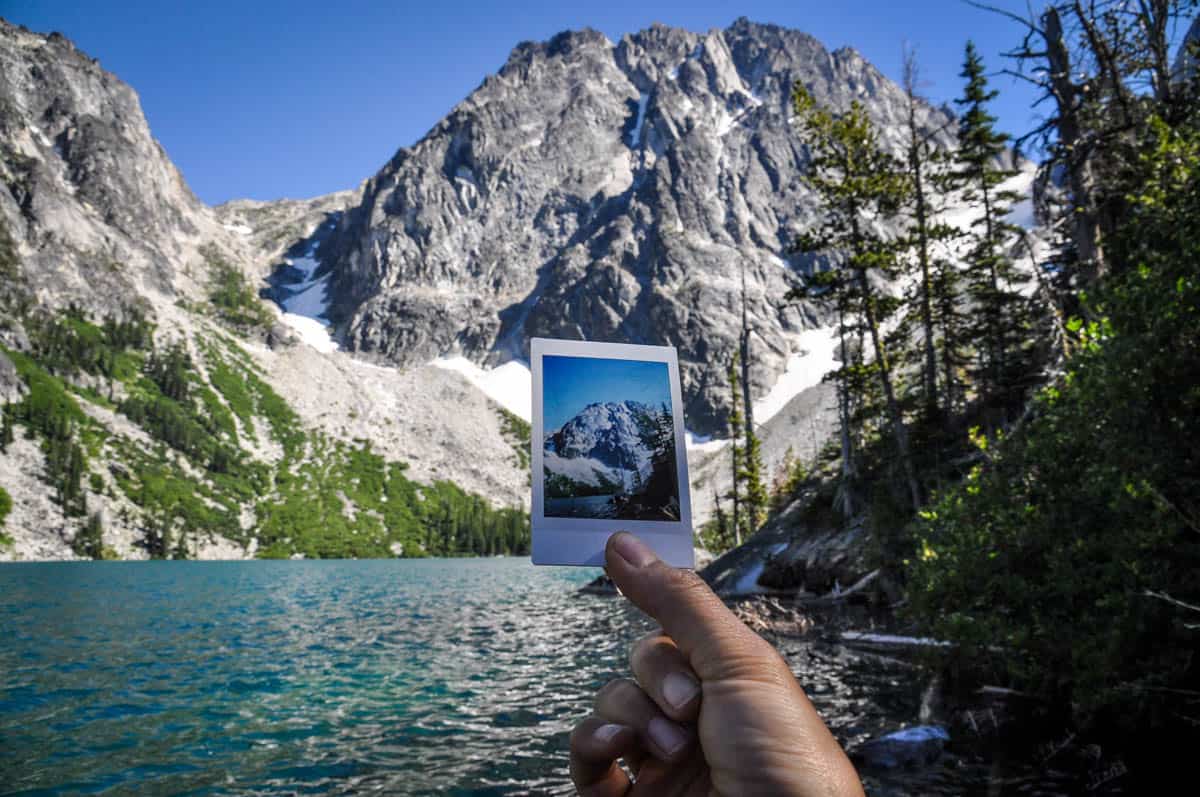
The trail to Colchuck Lake involves a gradual but steady incline. While it’s just under four miles from the trailhead to the lake, it’s a slooooow four miles.
On average, it takes most people 2-4 hours to reach the lake and another 1.5-3 hours to make the descent back out.
Factor in some time for picnicking, swimming, and relaxing lakeside, and it easily becomes a full-day endeavor.
While it’s entirely possible to knock the hike out in 4-5 hours, what’s the rush? We fully believe that hiking is about the journey and not just the destination, but in this particular case, the highlight is the spectacular teal blue jewel at the end.
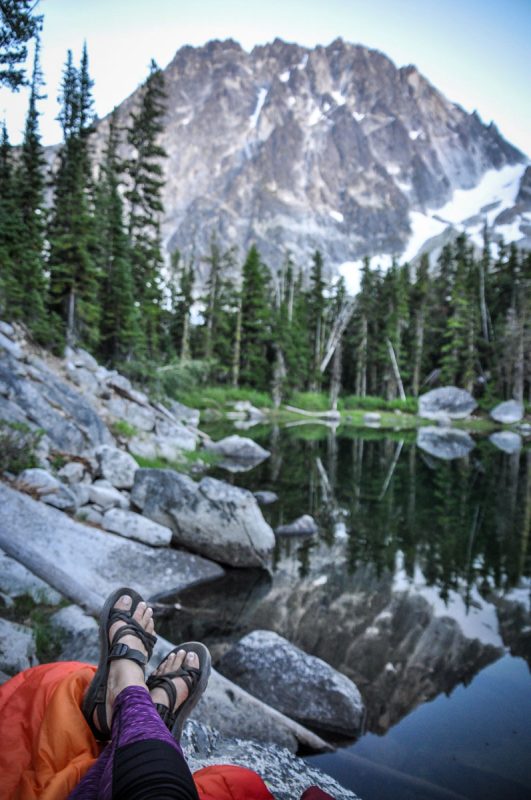
Camping on the shore may be a possibility, but it’s not especially likely.
Doing so involves winning an extremely hard-to-get permit through an online lottery. Only a very small percent of lottery entrants get one, and most use it to thru-hike the Enchantments (more on that later), rather than the Colchuck Lake trail.
To keep things simple and avoid having to plan months in advance, we recommend the hike as a full-day outing.
Psst! Check out our beginner’s guide to backpacking for everything you need to know to prepare for your first backpacking trip.
How difficult is the hike to Colchuck Lake?
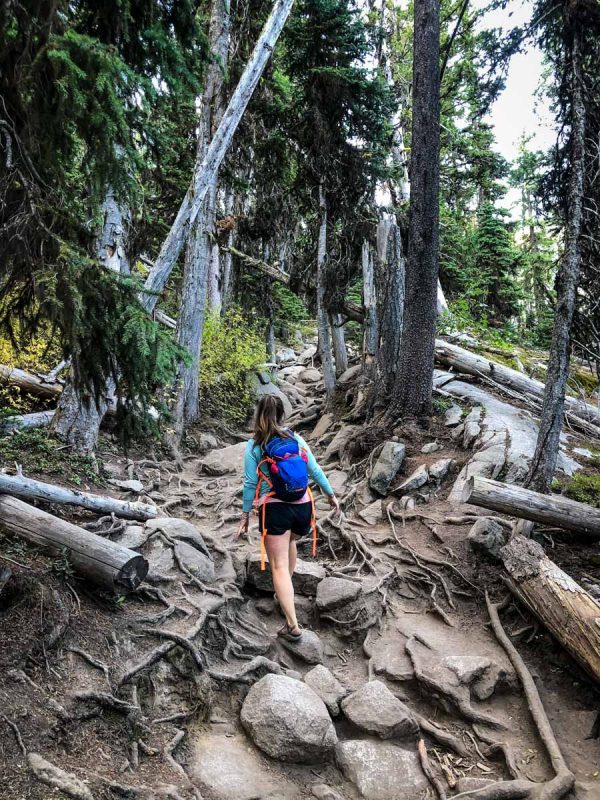
With 2,300 feet of elevation gain, reaching Colchuck Lake takes some perseverance, but it’s doable. Don’t get us wrong — it’s a strenuous hike, but we honestly think anyone who’s attempted other challenging hikes or those who are reasonably fit can do it.
The temperatures can creep up into seriously uncomfortable territory during the late summer, but most of the trail is (thankfully!) in the shade.
The hardest part of the hike is the final mile, where a steep incline requires every bit of your endurance to finally reach the lakeshore.
However, the trail itself is very well-maintained and while there are some rocks and roots to navigate, it never requires scrambling (unlike Aasgard Pass if you are continuing on to the Enchantments, past the lake).
Can you swim in Colchuck Lake?

Absolutely, and we definitely recommend it!
That said, it is pretty chilly.
After a long, sweaty hike on a summer’s day, jumping in the cold glacial waters a sweet and refreshing reward though.
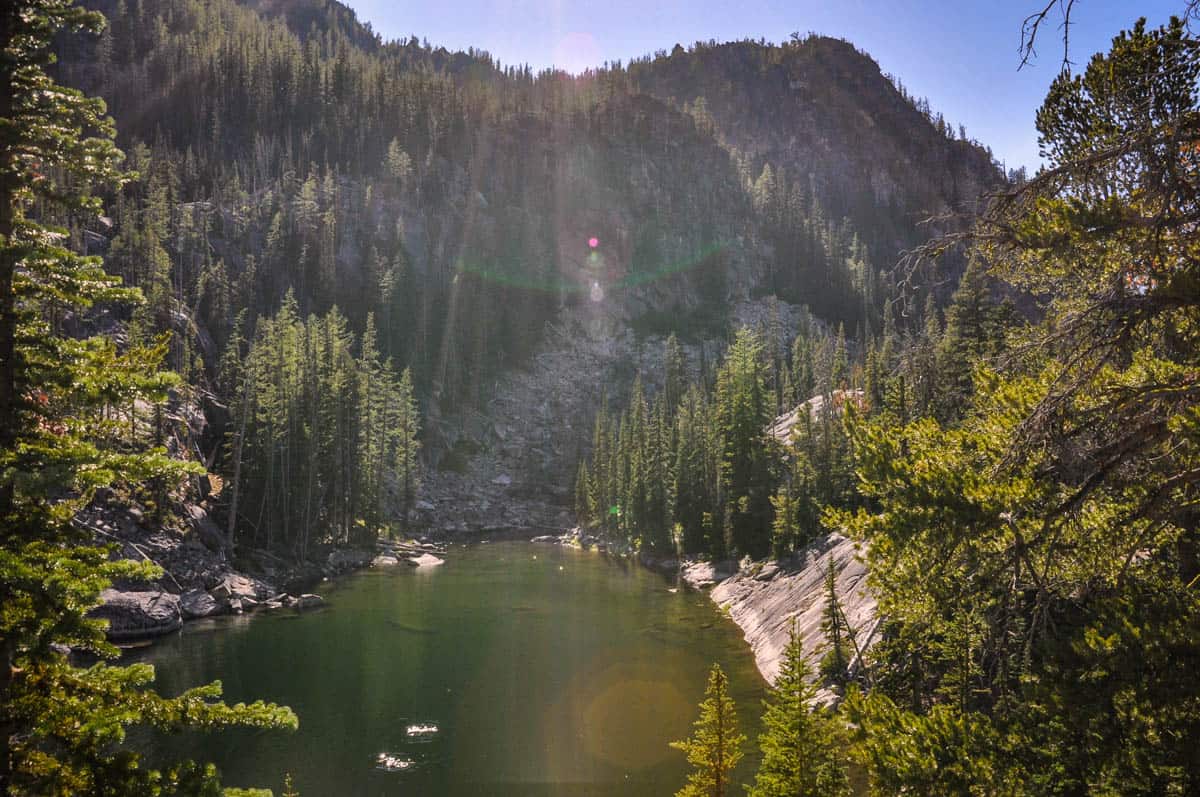
Insider Tip: For a slightly less chilly experience, the smaller pond to the West of Colchuck is really nice!
You can certainly go in your shorts (and a sports bra), but if you want to pack a swimsuit and a microfiber towel, you’ll be more comfortable.
Wildlife on the trail to Colchuck Lake
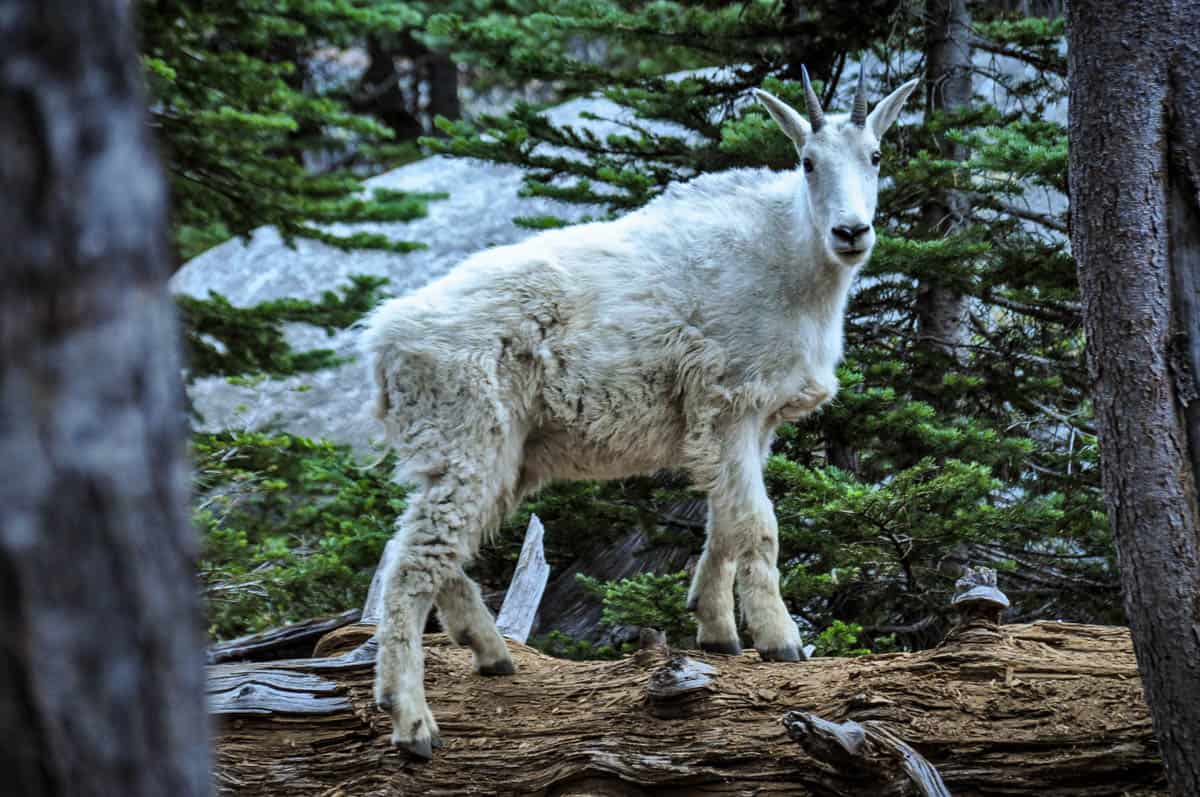
The entire Alpine Lakes Wilderness area is home to a vast variety of alpine wildlife: mountain goats, marmots, deer, picas, and the (very) occasional black bear.
No need to fear, though — unlike grizzlies, black bears are rarely aggressive. It’s still best to take precautions, though, so make sure to pack bear spray and a bear-proof food canister if you’re camping, to be on the safe side!
Mountain goats (& an important rule)
The most frequent animal encounters around Colchuck Lake are by far mountain goats.
While they’re adorable and it’s tempting to get close, rare instances have occurred where mother goats attacked hikers in an attempt to protect their kids.
Always try maintain a safe distance from the goats (and any other wild animals, for that matter!). I say “try” because sometimes the goats will sometimes approach you. Especially if you have recently peed.
Which leads me to another point…
Take care of your “business” well away from the trail and campsites.
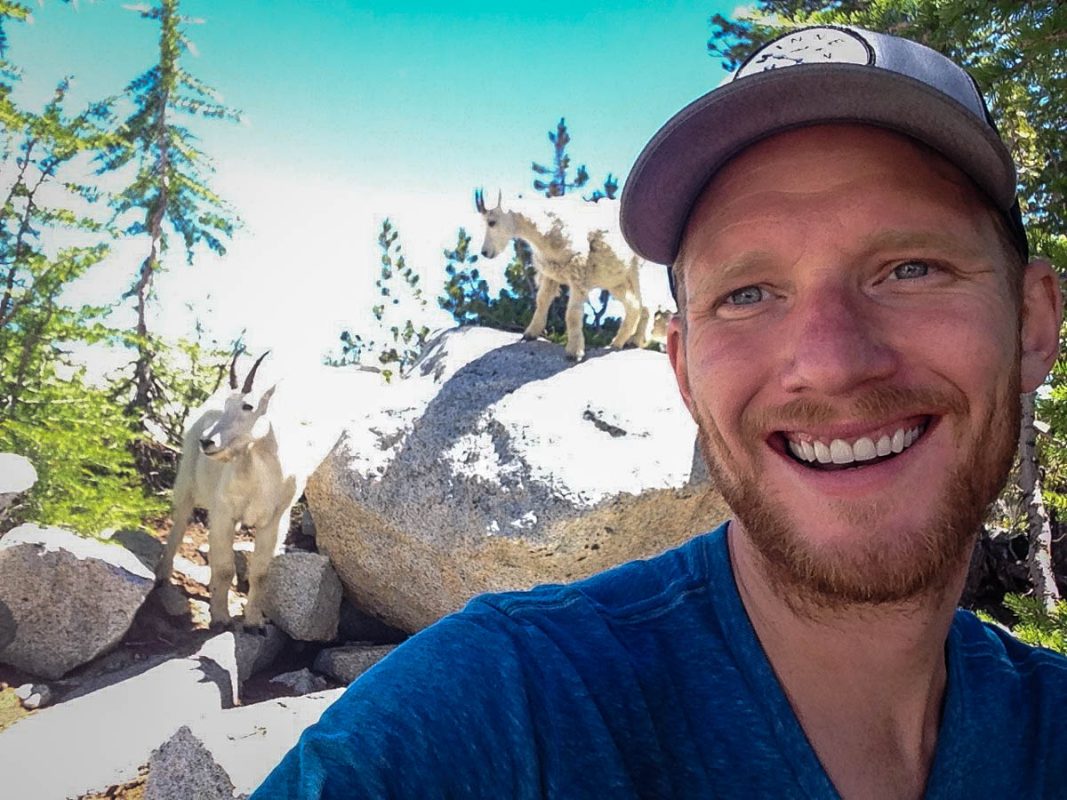
Mountain goats and other animals are attracted to the natural salts in urine and often seek out the smell.
For this reason, it is recommended that you urinate on rocks instead of on vegetation, as the goats will destroy plants when trying to, well, lick your salty pee. If you go on a rock, on the other hand, no damage will be done.

Colchuck Lake Trail: The Route
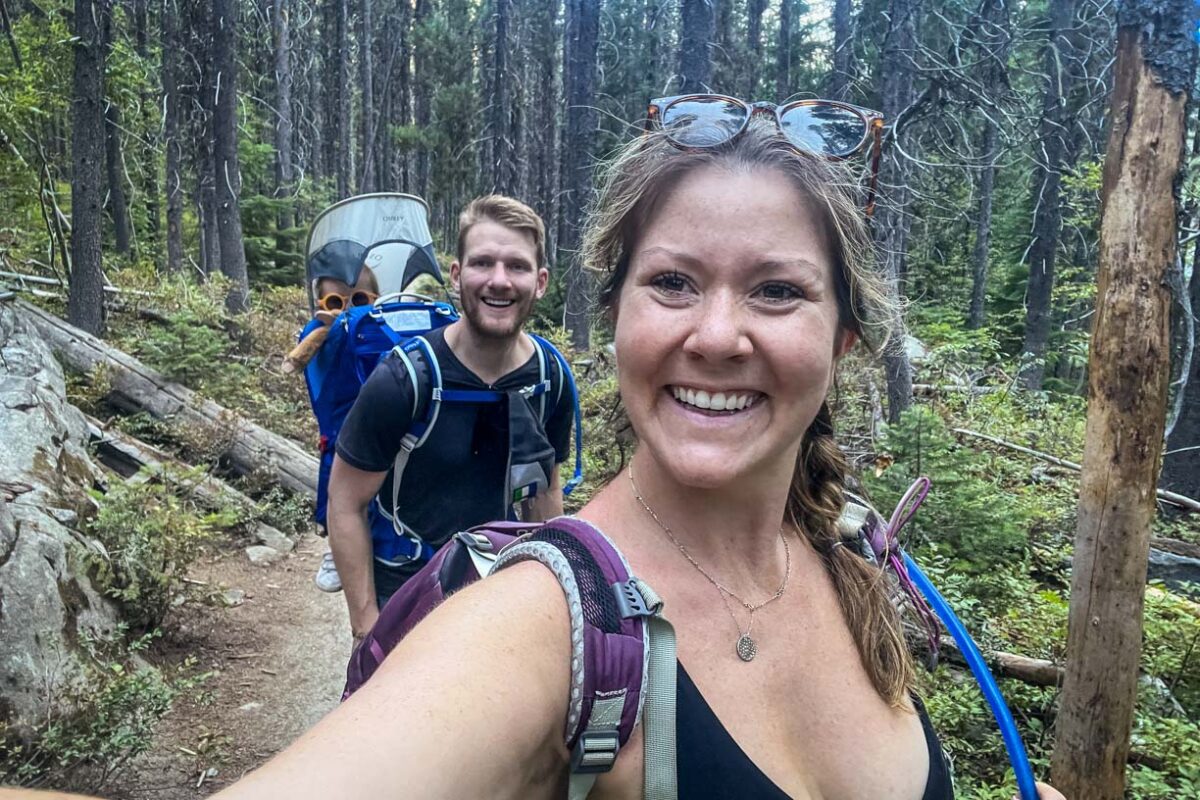
The Colchuck Lake hike starts as an easy-going walk through a peaceful, lush forest. It’s well-shaded, the wonderfully potent smell of pine trees fills the air, and chirping birds provide a tranquil soundtrack.
Enjoy this section of the trail, because you’ll need to muster up some motivation later on.
About 1.5 miles in, you’ll cross a very picturesque log bridge over Mountaineer Creek, which you’ll likely hear babbling as you approach. This bridge marks a notable change in the trail, where the steepness ramps up quite a bit. The forest floor also becomes a little trickier to navigate, with more rocks and roots.
About ¾ of a mile from the log bridge (if you use a GPS or fitness watch, this is a great hike to use it on!), look for the trail junction with Stuart Lake. While that hike makes a worthy trip on another day, if you don’t pay close attention, you’ll easily miss the turn. You want to take a left at the sign that reads, “Colchuck Lake Trail #1599.”

Not long after hanging that left, you’ll cross Mountaineer Creek again on another log bridge. The other side of the creek holds quite the surprise this time: a massive boulder field and the first good glimpses of the rugged peaks surrounding Colchuck Lake!
This part of the hike can be quite intimidating because it’s easy to lose the trail among the boulders. It’s not quite as tricky as it looks, though — turn right as soon as you get off the bridge, and make your way through (not over) the giant rocks. Keep your eyes open and you’ll pick the trail back up fairly quickly along the creek.
Pro tip: if it’s hot or you need a refresher, take a dip in the creek here. The hardest part of the trail is up next!

Just beyond the boulder field, the trail begins the somewhat brutal one-mile ascent to Colchuck Lake. The switchbacks start immediately and seem like they will never end, but keep reminding yourself this stretch is just one mile!
The sole silver lining here is that beautiful views of the surrounding valley break through the foliage every now and then, encouraging you to take frequent short breaks for water or to snap a photo.
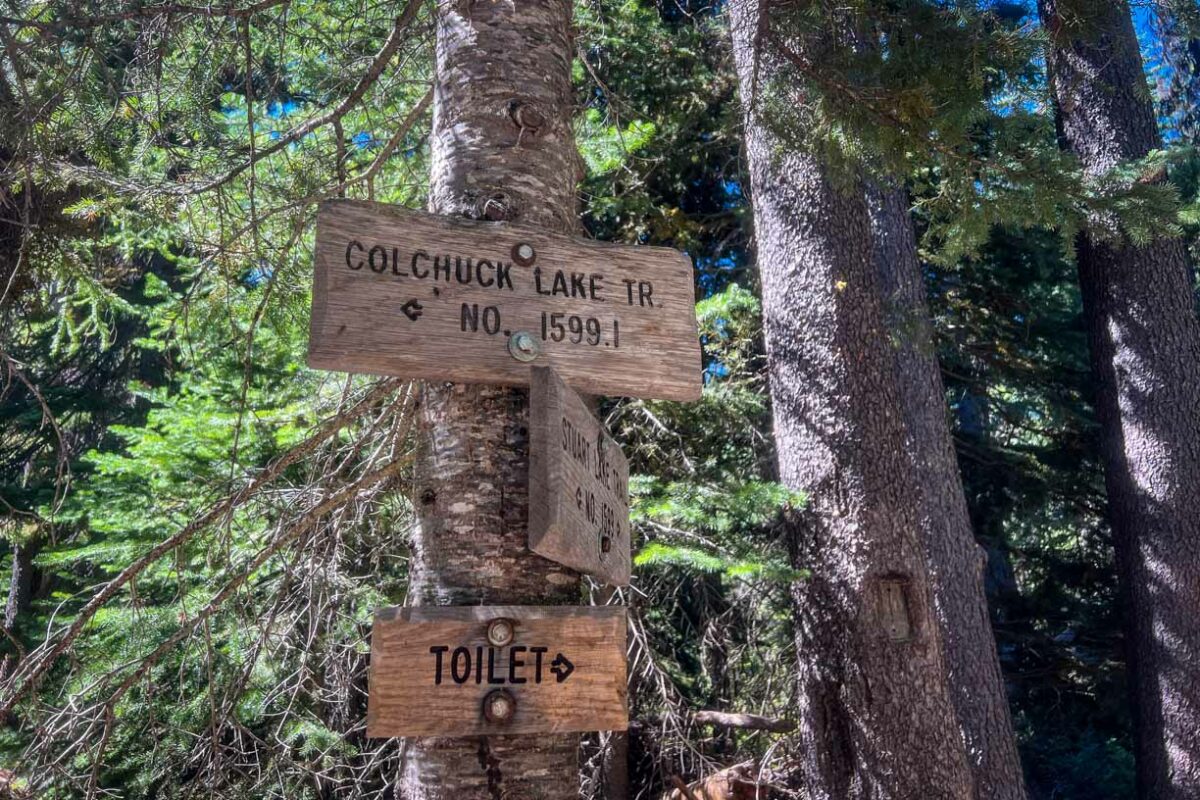
When you see the sign for the “toilet” (which is really just a pit dug in the ground, but strategically placed in one of the most scenic spots imaginable), you’re nearly there!
Just a few feet more and you’ll dip down, then immediately spot the unmistakable teal blue of the lake. An enormous granite rock face provides the backdrop for the lake which has several places for resting, picnicking, and cliff jumping into the water.
Once you’ve gotten some rest, be sure to explore more of the lakeshore and snap pictures from different vantage points. If you’re there when the sun happens to be rising or setting, take note of how the water color changes throughout the day.
Continuing on to hike The Enchantments Thru Hike
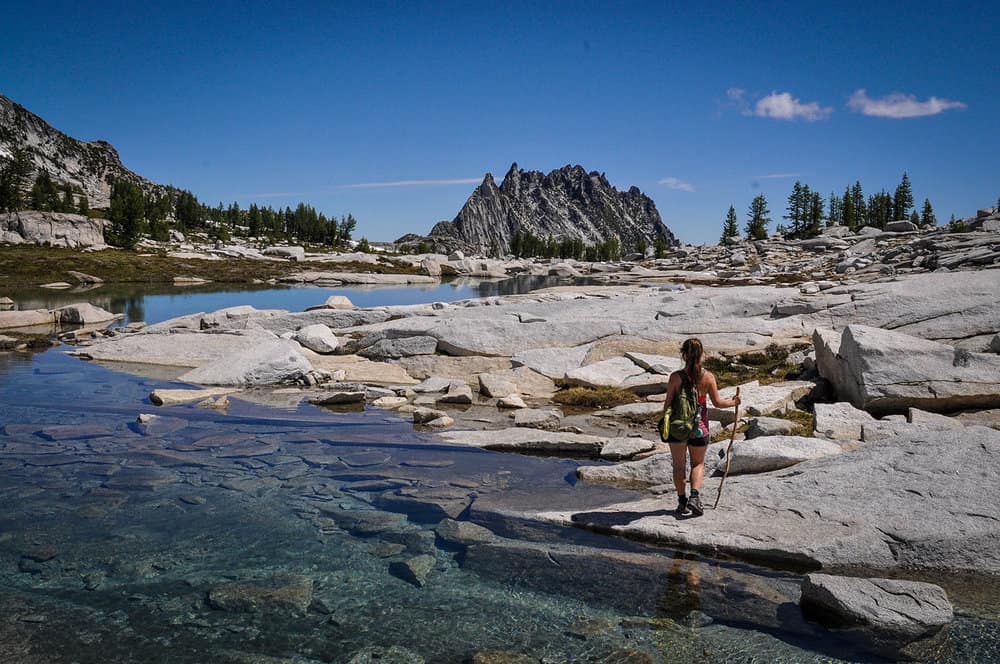
The Colchuck Lake Trail is the first section of the absolutely magical Enchantments — a much longer trail that continues over Aasgard Pass, which you can see at the south end of Colchuck Lake.
Filled with even more glacial lakes, meadows of wildflowers, impressive vistas, and rocky, otherworldly landscapes, the Enchantments is one of Washington’s most spectacular long hikes.
While some ultra-fit hikers tackle the Enchantments in one day, it’s best to camp along the route, which is 20 miles long, with over 5,000 feet of elevation gain.
However, overnight camping (including on Colchuck Lake’s shores) requires the permit we mentioned earlier, which you can only win via a competitive lottery. Securing a permit takes serious advance planning and more than a bit of luck, but it’s well worth the effort!
Read more in our complete Enchantments trail guide.

Essential tips for hiking to Colchuck Lake
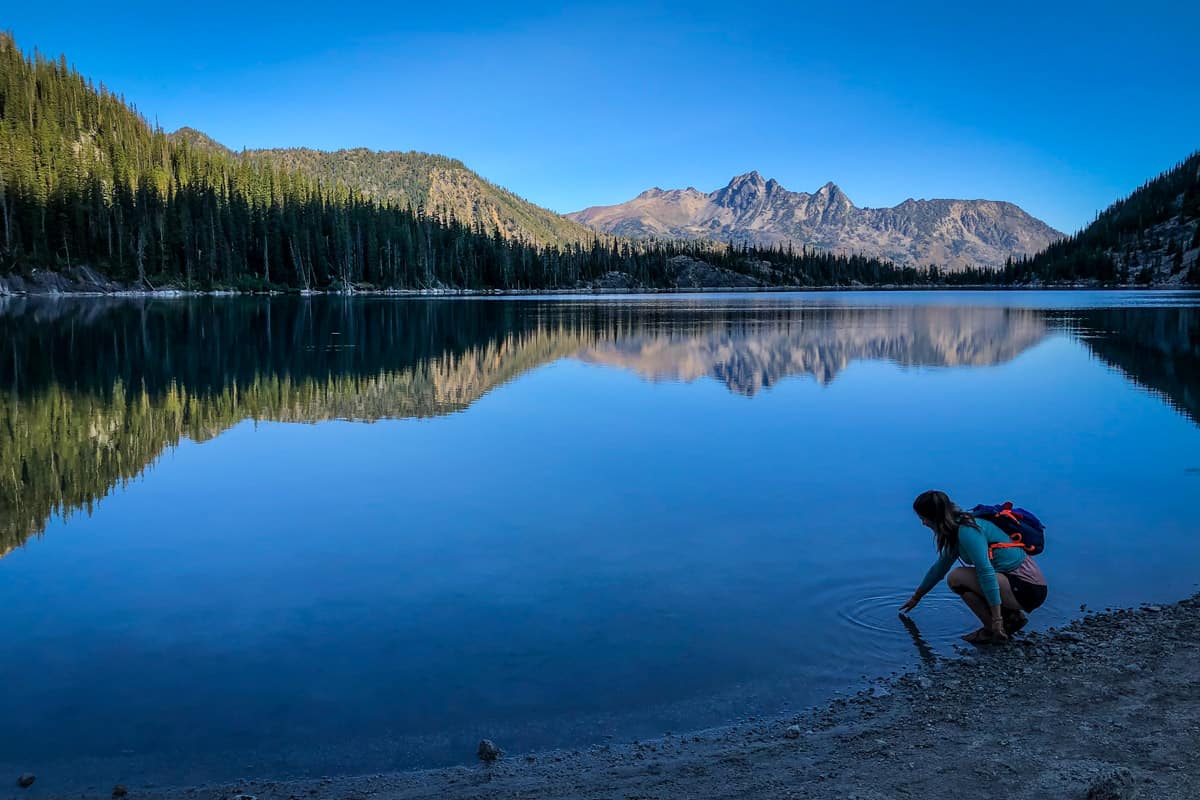
1. Arrive early to beat the morning crowd
Or if you’re a fast hiker, start in the mid-afternoon when morning hikers are already done. The trailhead parking lot gets very busy! There’s space for about 30 cars, but about half of them are designated for overnight permit holders.
If you can’t find a spot in the lot, parking is allowed on the forest road between Stuart Lake and the Eightmile trail — but this adds about a mile each way to your hike.
2. A Northwest Forest Pass is required
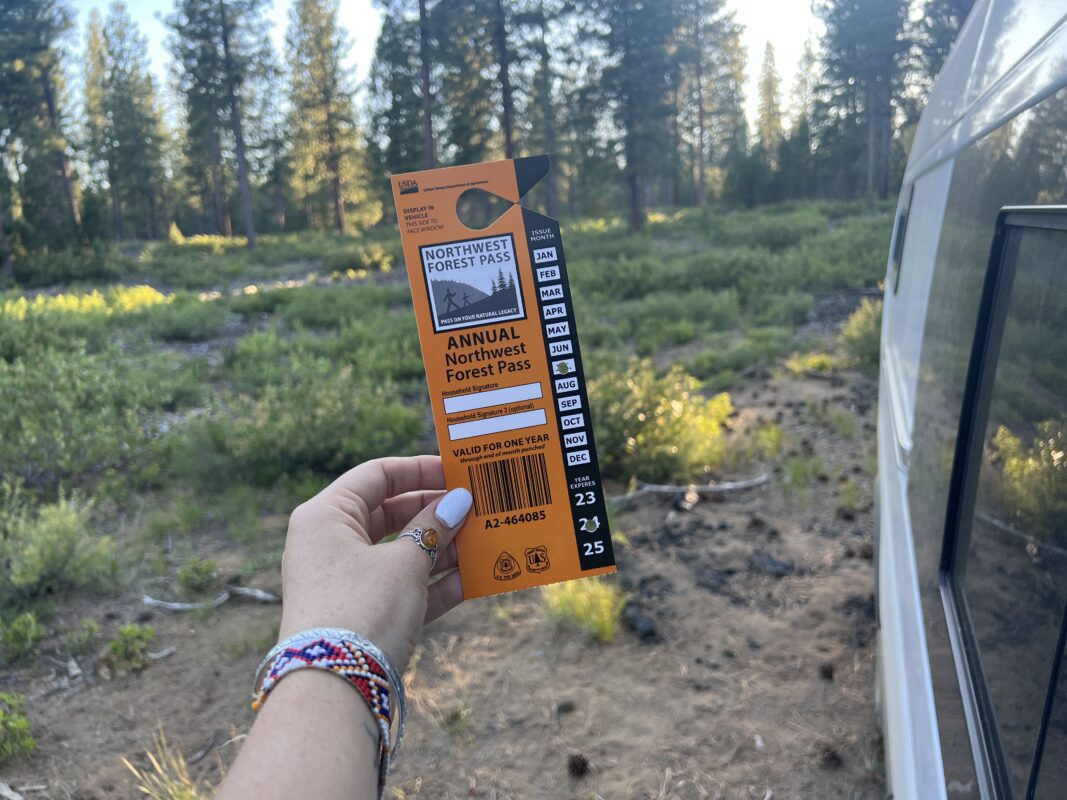
If you don’t have one displayed, you WILL get a ticket. You can purchase a day pass for $5 from a kiosk in the parking lot if you don’t have an annual pass.
3. The road to the trailhead is rough, with lots of potholes
However, just about any vehicle will make it if you drive really slow.
4. Pack bug spray!
Especially in August, mosquitoes are relentless around the water.
5. Wear your best hiking boots or trail runners
You might even consider using trekking poles. Especially on the descent, navigating all the rocks, roots, and steps is tough on the ankles.
6. Plan to stay a while
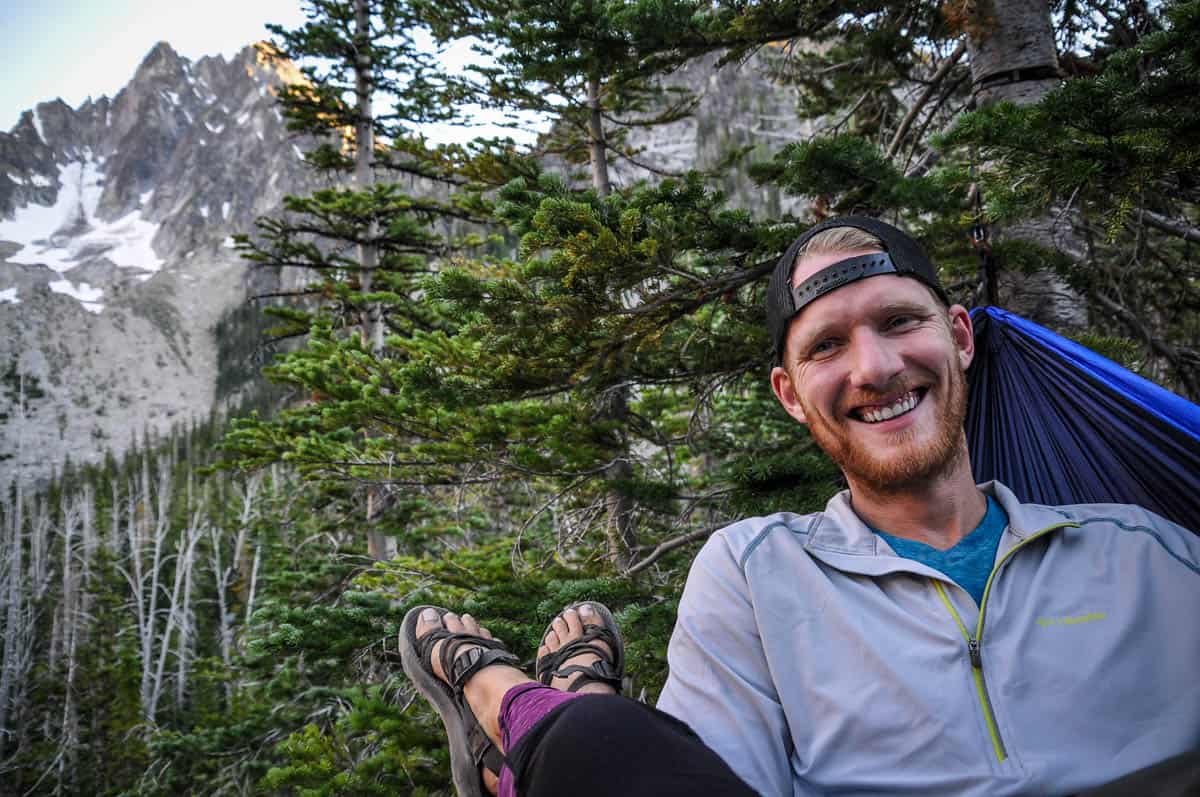
The hike to Colchuck Lake isn’t one you want to crush as quickly as possible. This is such a special place, that we’d definitely recommend packing a picnic lunch, a deck of cards, a book or journal, and a hammock (if you have one!).
This is a place to spend a lazy afternoon and soak in all the views.
7. There are only two toilets on the trail
One at the trailhead parking lot and an open one at Lake Colchuck. If you need to go when you’re not at one of these toilets, be prepared to do your business properly and follow Leave No Trace guidelines (aka carrying out TP in a bag and digging a hole for #2).
8. Pack a swimsuit if you’re hiking in the summer
The lake water feels cold at first, but after a bit of swimming, it’s the perfect respite!
Bring along a lightweight microfiber towel for a bit of added comfort after your dip.
9. Pack a water filtration device
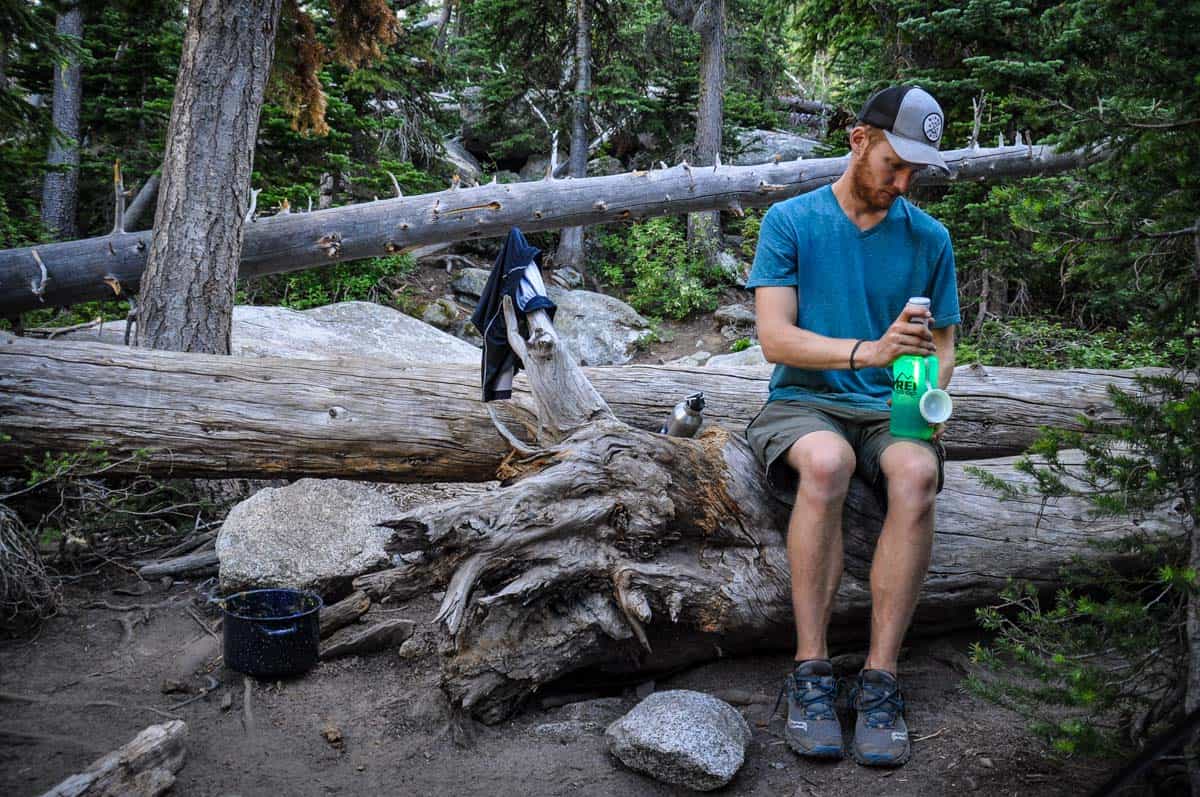
On any long-ish hike, we’d recommend spending some time thinking about what you will do for water.
If you are hiking to Colchuck Lake as a day trip, you may very well be able to pack enough water for the day in a bladder and some water bottles.
That said, we always like to be prepared and have a plan for filtration in case of emergency.
10. Watch out for roots and rocks on the trail
The trail to Colchuck Lake has many, many roots. And as you walk around the lake itself, you’ll be climbing over some rocks in places.
Watch your ankles and take it slowly when you need to.
Just as an example, we met a young man on this trail who was a very experienced hiker that had sprained or potentially broken his ankle and was really struggling to make it back down the trail. Thankfully, he was prepared with emergency food rations and extra layers. But it was a good reminder for us to always be prepared.
Which leads me to my last point…
11. Pack the hiking essentials
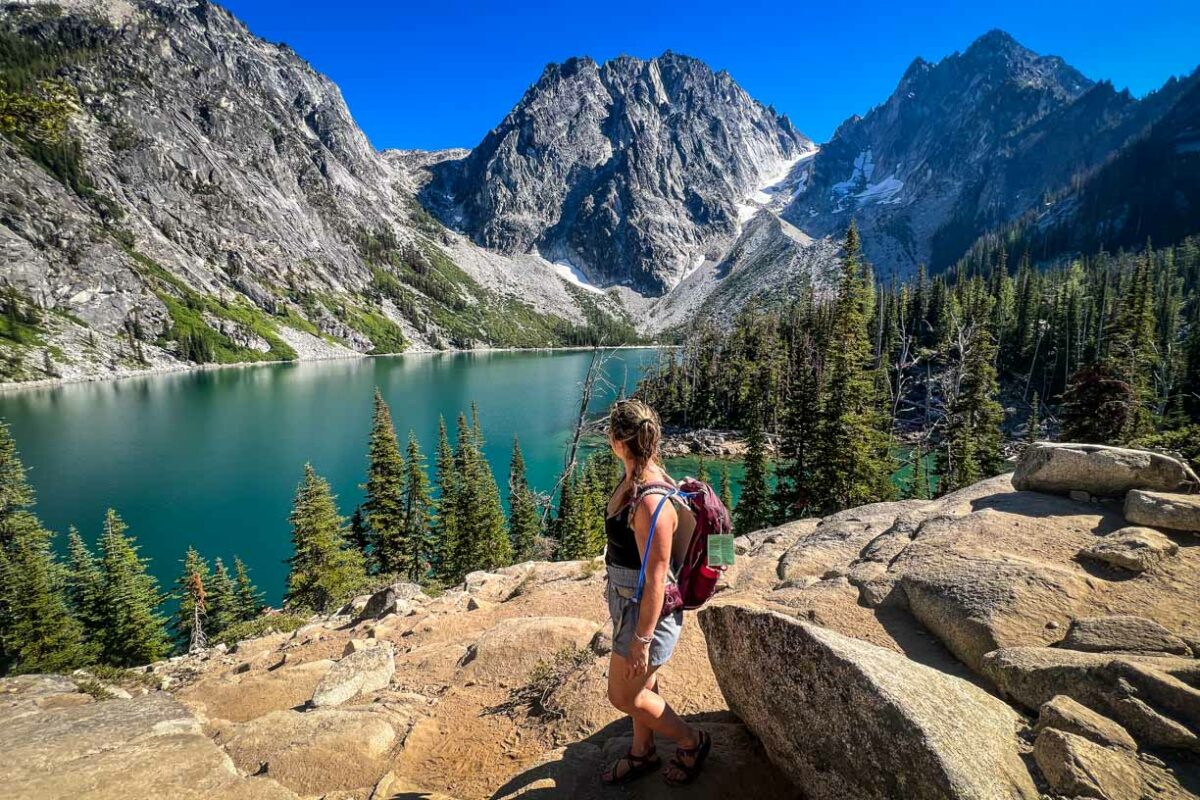
While this trail is well-trafficked, you will definitely want to be prepared with first aid items and food, just in case. It is a long hike back to your car, after all…
Camping at Colchuck Lake
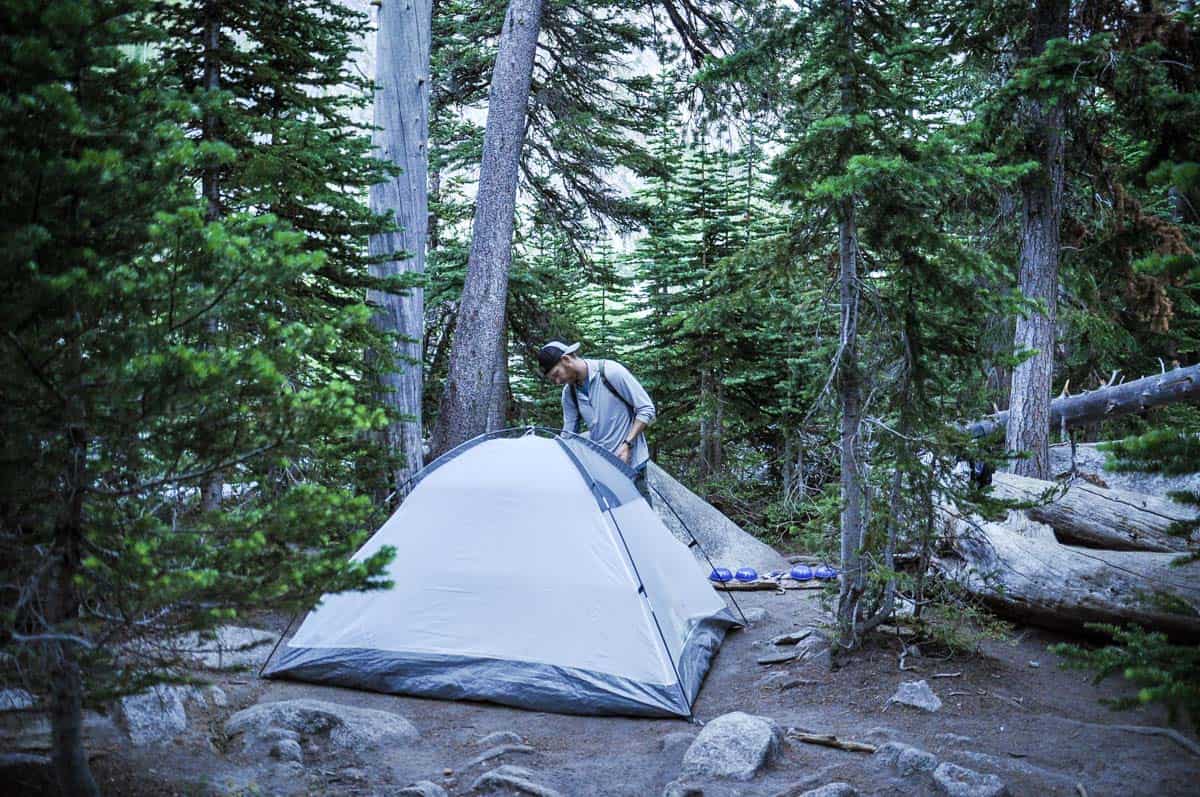
There are a handful of campsites along the Colchuck Lake trail, near the shore.
While it’s a stunning camping location, you can’t just pack your tent and go.
Between May 15 and October 31, you need to have an elusive overnight permit to camp here.
Obtaining this permit means entering the same highly competitive lottery as (many!) other hikers embarking on the full Enchantments hike.
You must apply for one between February 15th and the end of the month, and winners are notified the first few days of March.
We have applied for this (very competitive!) lottery for many years, and have only gotten permits once – on our first time!
Another option is to camp at nearby Stuart Lake, which shares a couple of miles of the trail. A stunning alpine lake in its own right, Stuart Lake also requires permits, but they’re far less competitive.
Campgrounds near Colchuck Lake

If you’re not one of the lucky permit holders, don’t worry – there are other options for camping near Colchuck Lake.
We’re big fans of Eightmile Campground, which is not far from the trailhead, situated along Icicle Creek. This is a National Forest campground, which offers both first-come, first-served and reservable sites.
Another option is nearby Bridge Creek, which is just a bit further up Icicle Road from Eightmile. This campground has six dispersed, first-come, first-served sites. (Most of these sites are not very shaded, but they are very nice.)
Good to know: If you’re camping in an RV, just remember, the roads around this area are a bit rough!
What to pack for the Colchuck Lake hike
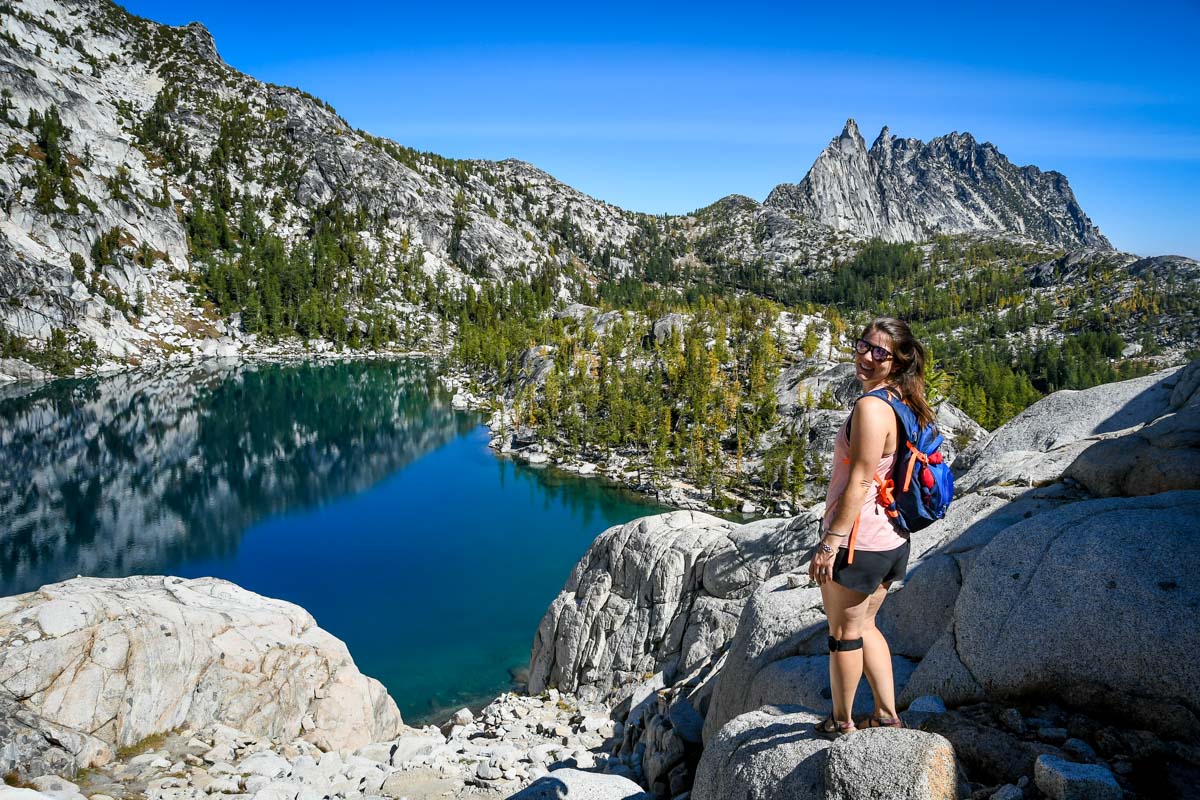
- Navigation: we recommend using Alltrails+ to download the offline trail map
- Get your first week of using Alltrails+ for FREE when you sign up using our link!
- Permit (obtained at the trailhead)
- Water bottles and bladder for your Camelbak
- Way to purify your water (we love our Grayl water bottles, and before them we always brought along our Steripen)
- Warm layers (here is a great resource if you’re wondering what to wear hiking)
- Rain jacket
- Hiking boots
- Microspikes (if there is any chance of snow and ice)
- Hiking poles (optional)
- Bug spray
- Sun protection: sunscreen, hat, sun glasses
- Headlamp
- Battery pack (if you are relying on your phone)
- Camera and tripod (this is our favorite for hiking)
- Bear spray (just in case)
- Bear canister (to properly store your food)
- Multi-tool
- Toilet kit: toilet paper, small shovel, bag for packing out TP, hand sanitizer
- Plenty of snacks: check out our favorite hiking snacks here!
*If you choose to us your phone for navigation, be sure to bring a reliable battery pack to charge your phone
Be sure to grab our ultimate hiking packing list includes our must-have gear for any hiking trail!
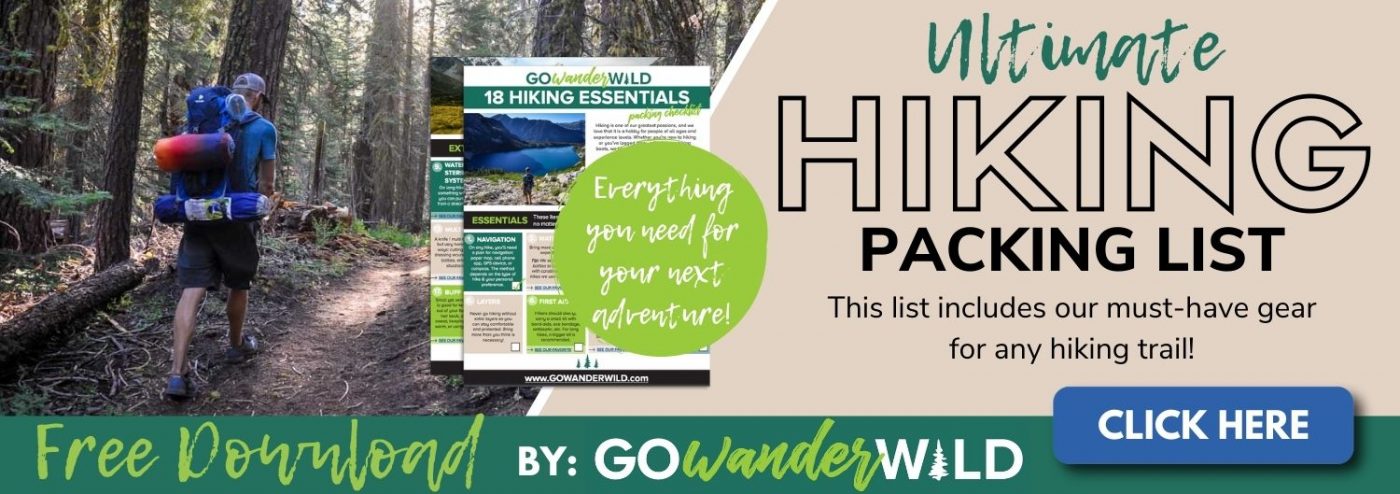

You may also like…
- Best Hikes Near Leavenworth, Washington
- Best 2-Person Tents for Camping & Backpacking
- Top 50 Hikes in Washington State
- How to Find Discounted Outdoor Gear
Save this article on Pinterest for later!
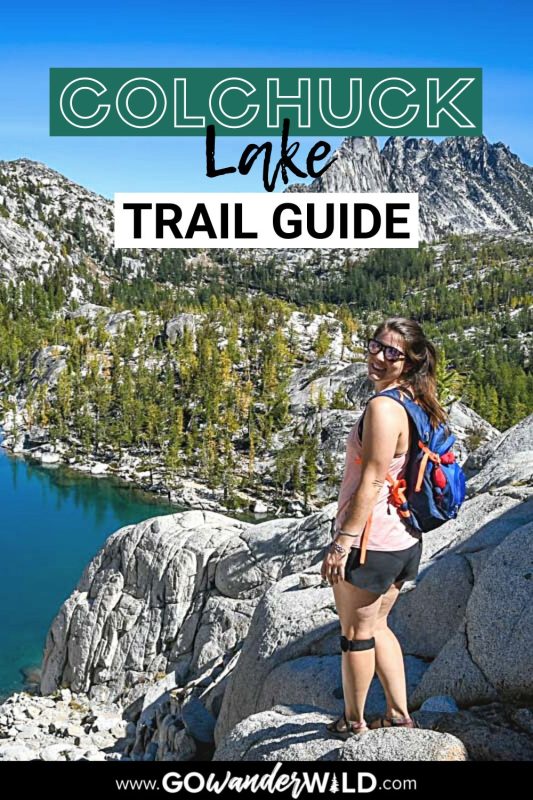
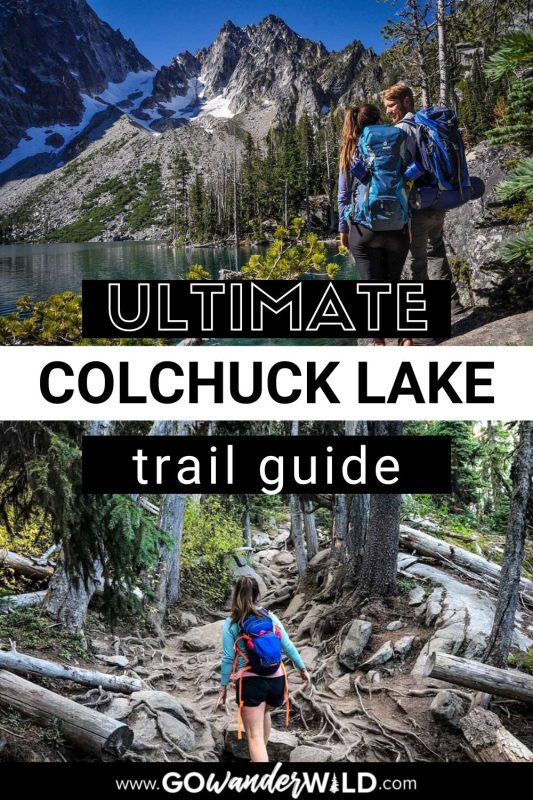
We want to hear from you!
Comment below if you have questions about hiking the Colchuck Lake trail in Washington state and we’ll do our best to get back to you!

